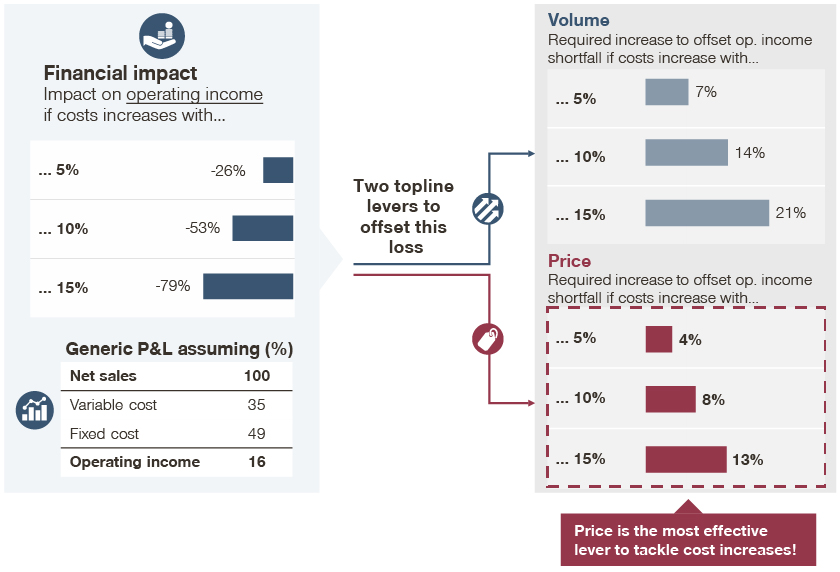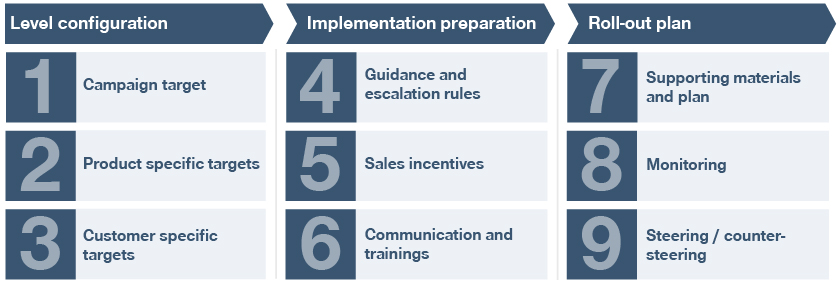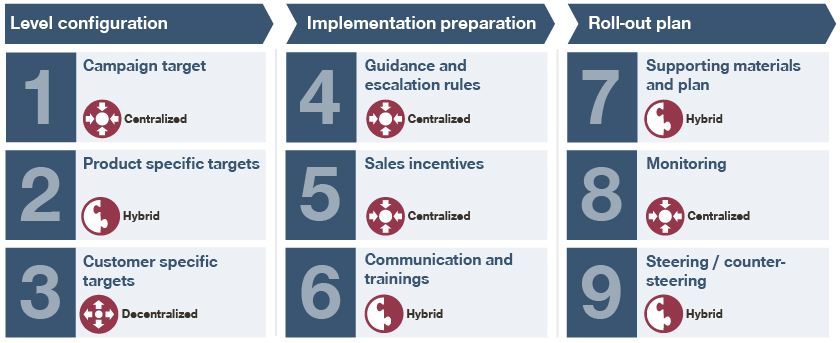It’s all over the media: Inflation rates are at a historic high. Consumer prices in the OECD area rose by 8.8 percent year-on-year in March 2022, compared to 2.4 percent in March 2021. This alarming development is affecting all industries and regions, with no end in sight.
To avoid this surging inflation, medtech companies need to take countermeasures now. Otherwise, they are stuck with the cost increases. The good news is, raising prices even minimally can recoup the loss of operational income caused by cost increases.

Given the prevalent discussions and current high awareness of inflation rates, implementing price increases like these is easier than ever.
The healthcare market is primed for price increases
This development has been confirmed by a study conducted between December 2021 and March 2022 with more than 3,000 respondents from numerous industries. A total of 32 percent of the participants expect cost increases of six to over 30 percent. When considering the magnitude of these cost increases, it becomes clear that efficiency gains and cost reductions elsewhere will not be sufficient to maintain profitability. Consequently, 41 percent of B2B users surveyed said they plan to pass the cost increase on to business customers as a price increase.
How to increase prices without deterring customers
As you can see, the healthcare market including the medtech sector is ready to increase prices. Therefore, the key question is how to do so without:
- breaking the contract?
- “waking the sleepers”?
- increasing churn?
- incurring negative publicity?
As so often in life, preparation is the key to success. The saying “fail to prepare, prepare to fail” might be old, but still holds true.
Distilled from many best practice projects is our proven Smart Price Increase Framework. A nine-step approach that helps medtech companies to successfully increase their prices while avoiding the most common pitfalls. It is structured in three phases – level configuration, implementation preparation, and roll-out – and addresses the key questions companies have regarding price increases.
Phase one: level configuration

Define the your campaign target
The most common mistake companies make when trying to work out how much to increase prices, is relying on gut feeling rather than facts. That’s why the first step should always be to understand the cost impact of inflation and quantify the minimum net price increase required to offset that difference. Next, analyze cost developments and price potential by region and review existing contracts to identify revenue that can be targeted. Furthermore, evaluating the contract situation is helpful to identify risks and potential levers working in your favor. Lastly, make sure only relevant revenues are being considered and align chosen targets with C-level management.
Outline your product-specific targets
Once you have found out how high the price increase target is, you have to decide how to allocate the target price increase to your products. The competitive situation and customer lock-in can vary greatly depending on the product. A uniform price increase for all your products is not the optimal approach and will cause you to risk revenue for some products while missing out on the potential for others.
Instead, differentiate price increase targets by product, e.g., based on competitive advantage, price-to-volume ratio, value-to-price ratio, lifecycle, and product profitability.
Plan your customer-specific targets
Which customers should receive a price increase? Setting the same targets for all accounts without considering their specific situation is a recipe for failure. Like in the previous step, you need to differentiate, e.g., by considering criteria like duration business relationship, economic situation of accounts, importance of our offering for the customer’s business, and the segment’s strategic relevance.
Phase two: implementation preparation
Provide guidance and escalation rules
As soon as price negotiations start, your sales teams need to know exactly what decisions are up to them. Avoid giving only high-level guidance without effectively disclosing the details sales teams need to prepare. In addition to clear sales guidance, explicit approval rules in the case of derogations are also a prerequisite.
Introduce sales incentives
Start rewarding successful price increases (on top of your existing compensation plan) to ensure full commitment to your targets. A mix of financial and non-monetary incentives is ideal to send the right signal to the entire team. Price increase incentives, for example, can be calibrated to be self-financing with little or no impact on the budget. Non-monetary recognition and communication of good performance can also go a long way.
Improve communication and training
Untrained sales force increases the risk of upcoming negotiations failing to a significant degree. Spend time thinking through the rationale behind your price increase and communication story. Make sure managers explain the targets to your team and provide them with detailed communication material and specialized training.
Phase three: rollout
Create supporting materials and a detailed plan
When rolling out your price initiative, make sure that your sales team has everything it needs including the answers to any possible questions customers could ask. Prepare battle cards, argumentation guidelines, concessions, and negotiation plans for every account and product. This way, it’s easier to avoid reactive communication not in line with the agreed communication strategy.
Implement monitoring
To find out if you’re successful, make sure to monitor relevant KPIs like price guideline deviation, migrated revenue, and roadmap/timing for negotiations. To ensure monitoring is effective, establish those KPIs early on and make them the basis to assess price realization.
Establish steering/counter-steering
The most meticulous monitoring is of no use if you don’t have a plan on how to act in case of fulfillment or deviation from the agreed targets. It is essential to have pre-define steps prepared that clearly define what actions must be taken for each case. For instance, use sales champions to support negotiations, hold one-on-one coaching sessions with the respective salespeople, and establish adjusted price increase targets for customers to improve performance.
Centralized, decentralized, or hybrid approach?
We typically see companies approaching these challenges in a highly centralized or decentralized manner. Each method has its own shortcomings. Implementing the framework exclusively steered by the headquarter way often leads to a lack of realistic goals, local buy-in is difficult to achieve, and targets are often missed.
On the other hand, a decentralized approach can result in a lack of ambition, inconsistent customer experience, and the absence of synergies. Instead, follow a hybrid approach that is tailored to each step’s individual conditions. The following is an example of how a medtech company successfully implemented a price increase program.

The time to act is now
Preparing for successful price increases takes time and effort, so it’s essential to start early on. Inflation rates and increasing costs are putting your margins under pressure. Waiting to act will only increase the burden as this situation is not likely to change anytime soon. Right now, the medtech market is primed for price increases. Take hold of this opportunity by applying our proven framework.
Reach out to our authors if you want to learn more!








